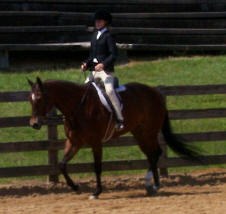|
Equine Kingdom Riding Academy
is no longer in operation. These more than 2,000 unique pages are provided for historical and educational reference. |
||
|
|
||
|
|
- Posting Trot - |
|
|
When you post to the trot,
you rise up out of the saddle for one beat, and then sit down in
the saddle again for one beat, while gripping with your knees to
stay on. Posting is done in the same rhythm with which the horse
moves its legs and back throughout the gait. Push your hips forward
and up in a smooth thrusting movement, but don't over-do it or you'll
look ridiculous. Your lower leg remains in the same position throughout,
because you should be gripping with your knees and only your upper
leg moves. As soon as you return to the saddle, be ready to receive
the forward and upward thrust of the horse's back in a smooth continuous
movement. Don't go up too high; only go up high enough to get out
of the saddle. The best way to do this is to post without stirrups.
The height you rise while you're not using stirrups is the same
height you should post when you've got your feet in the stirrups. You should learn to post on the correct diagonal - which has the fore leg moving forward when you are in the up position of posting the trot. As the horse's leg the closest to the fence goes forward, you should be rising in the saddle. As that leg goes back you should be sitting in the saddle, and so forth. The horse moves its legs in diagonal pairs at the trot; that's why it's called "posting on the diagonal". The off fore leg and the near hind leg are called the right diagonal, and the off hind leg and the near fore leg are called the left diagonal. Your posting will feel strange if you are posting on the wrong diagonal. If you find yourself on the incorrect diagonal, to change it simply sit in the saddle twice, called "bounce, bounce", commonly. Then when you begin rising again you'll be on the correct diagonal. When you change direction while you're riding don't forget to change your diagonal too. Back to the Horse Care page |
|





 Posting
is done to make the trot, a two-beat gait, easier to bear. The trot
has two beats with a moment in the air, and the rider rises up and
down with every other beat to make the ride more comfortable. The
moment in mid-air is called suspension. Because the horse's back
moves up and down as it trots, you must synchronize your lower back
and pelvis to the rhythm of the horse's back in order to avoid being
bounced up and down mercilessly - which I guarantee will happen
(believe me, I know!).
Posting
is done to make the trot, a two-beat gait, easier to bear. The trot
has two beats with a moment in the air, and the rider rises up and
down with every other beat to make the ride more comfortable. The
moment in mid-air is called suspension. Because the horse's back
moves up and down as it trots, you must synchronize your lower back
and pelvis to the rhythm of the horse's back in order to avoid being
bounced up and down mercilessly - which I guarantee will happen
(believe me, I know!).